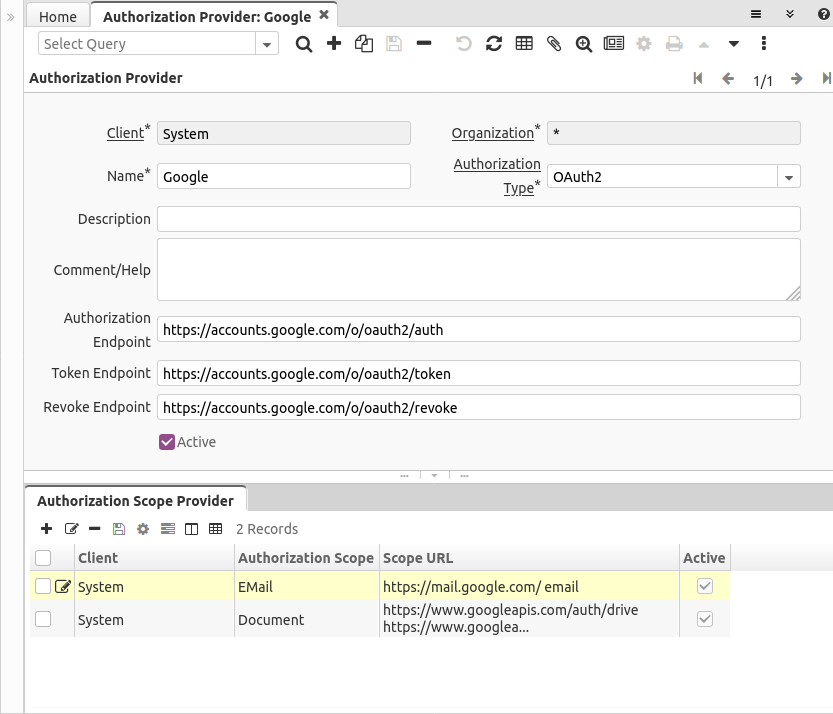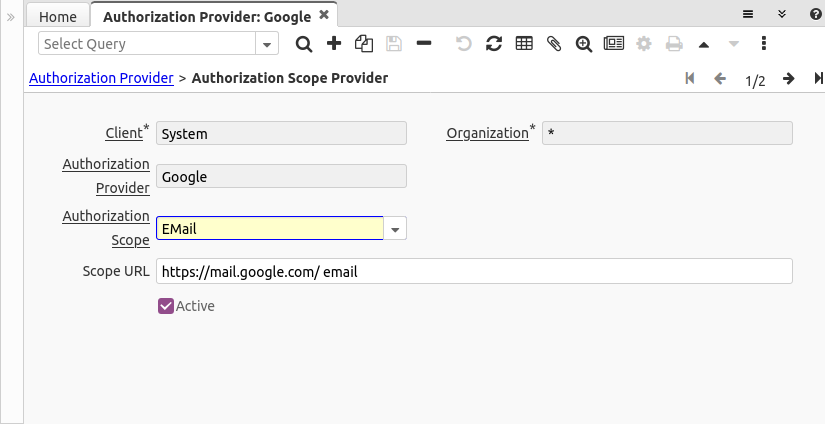Authorization Provider (Window ID-200112)
Window: Authorization Provider
Description:
Help:
Tab: Authorization Provider
Description:
Help:
| Name | Description | Help | Technical Data |
|---|---|---|---|
| Tenant | Tenant for this installation. | A Tenant is a company or a legal entity. You cannot share data between Tenants. | AD_AuthorizationProvider.AD_Client_ID numeric(10) Table Direct |
| Organization | Organizational entity within tenant | An organization is a unit of your tenant or legal entity - examples are store, department. You can share data between organizations. | AD_AuthorizationProvider.AD_Org_ID numeric(10) Table Direct |
| Name | Alphanumeric identifier of the entity | The name of an entity (record) is used as an default search option in addition to the search key. The name is up to 60 characters in length. | AD_AuthorizationProvider.Name character varying(60) String |
| Authorization Type | AD_AuthorizationProvider.AD_AuthorizationType character varying(10) List | ||
| Description | Optional short description of the record | A description is limited to 255 characters. | AD_AuthorizationProvider.Description character varying(255) String |
| Comment/Help | Comment or Hint | The Help field contains a hint, comment or help about the use of this item. | AD_AuthorizationProvider.Help character varying(2000) Text |
| Authorization Endpoint | AD_AuthorizationProvider.AuthorizationEndpoint character varying(2000) String | ||
| Token Endpoint | AD_AuthorizationProvider.TokenEndpoint character varying(2000) String | ||
| Revoke Endpoint | AD_AuthorizationProvider.RevokeEndpoint character varying(2000) String | ||
| Active | The record is active in the system | There are two methods of making records unavailable in the system: One is to delete the record, the other is to de-activate the record. A de-activated record is not available for selection, but available for reports.
There are two reasons for de-activating and not deleting records: (1) The system requires the record for audit purposes. (2) The record is referenced by other records. E.g., you cannot delete a Business Partner, if there are invoices for this partner record existing. You de-activate the Business Partner and prevent that this record is used for future entries. |
AD_AuthorizationProvider.IsActive character(1) Yes-No |
Tab: Authorization Scope Provider
Description:
Help:
| Name | Description | Help | Technical Data |
|---|---|---|---|
| Tenant | Tenant for this installation. | A Tenant is a company or a legal entity. You cannot share data between Tenants. | AD_AuthorizationScopeProv.AD_Client_ID numeric(10) Table Direct |
| Organization | Organizational entity within tenant | An organization is a unit of your tenant or legal entity - examples are store, department. You can share data between organizations. | AD_AuthorizationScopeProv.AD_Org_ID numeric(10) Table Direct |
| Authorization Provider | AD_AuthorizationScopeProv.AD_AuthorizationProvider_ID numeric(10) Table Direct | ||
| Authorization Scope | AD_AuthorizationScopeProv.AD_AuthorizationScope character varying(10) List | ||
| Scope URL | AD_AuthorizationScopeProv.ScopeURL character varying(2000) String | ||
| Active | The record is active in the system | There are two methods of making records unavailable in the system: One is to delete the record, the other is to de-activate the record. A de-activated record is not available for selection, but available for reports.
There are two reasons for de-activating and not deleting records: (1) The system requires the record for audit purposes. (2) The record is referenced by other records. E.g., you cannot delete a Business Partner, if there are invoices for this partner record existing. You de-activate the Business Partner and prevent that this record is used for future entries. |
AD_AuthorizationScopeProv.IsActive character(1) Yes-No |
Contributions / Posts
- See also Configure OAuth2 EMail


